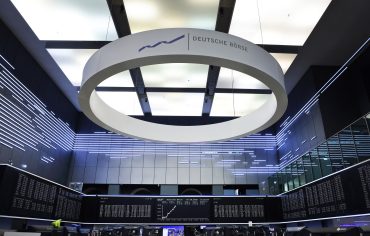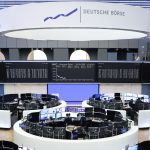
- Global Markets
- Semiconductors
- Trade Policy
European Markets Rally as US-China Extend Tariff Truce
5 minute read

Global stock markets welcome temporary relief as U.S.-China trade negotiations extend existing tariff levels through November
Key Takeaways
- European stocks rise on 90-day tariff extension – DAX gained 0.3%, CAC 40 up 0.5%, and FTSE 100 rose 0.4% after U.S.-China extended tariff truce until November 10
- U.S. CPI data could reshape Fed policy – July inflation report expected to show 2.8% annual increase, with 80% probability of quarter-point rate cut next month
- Tech supply chains accelerate diversification – Companies pursue “China+1” strategies in Vietnam, India, and Malaysia while tariff relief supports semiconductor valuations
Introduction
European markets rallied on Tuesday as investors welcomed a 90-day extension of the U.S.-China tariff truce, providing temporary relief from escalating trade tensions. The pan-European STOXX 600 index climbed 0.4%, with technology stocks leading gains amid improved risk sentiment.
The tariff extension delays duties that were set to reach 30% on Chinese imports and 10% on U.S. exports, cushioning near-term cost pressures for manufacturers. Market attention now shifts to U.S. inflation data, which could influence Federal Reserve policy decisions and determine the sustainability of the current rally.
Key Developments
Washington and Beijing extended their tariff truce until November 10, staving off triple-digit duties that could have significantly hindered bilateral trade. The agreement maintains current tariff levels, with U.S. duties on China ranging between 30% and 50%, while Chinese tariffs on U.S. goods remain at 10% to 20%.
The extension establishes groundwork for a potential meeting between U.S. President Donald Trump and Chinese President Xi Jinping later this year. This development provides businesses with a crucial window to adjust supply chain strategies and import schedules ahead of the holiday season.
Companies are accelerating “China+1” diversification strategies, shifting operations to Vietnam, India, Malaysia, and Indonesia to reduce tariff exposure while maintaining market access. U.S. retailers and electronics manufacturers are pulling forward imports during the 90-day window to avoid potential November tariff implementations.
Market Impact
German markets responded positively, with the DAX index advancing 0.3%, while France’s CAC 40 gained 0.5% and the UK’s FTSE 100 rose 0.4%. Technology and semiconductor stocks benefited most from the improved risk sentiment and reduced tail risk concerns.
Asian markets reflected similar optimism, with the Shenzhen Component Index rising 1.48% following the announcement. Major technology benchmarks including TSMC and Samsung experienced renewed buying interest as investors positioned for supply chain reallocation opportunities.
U.S. stock futures edged higher, with S&P 500 contracts rising 0.2% and Dow Jones Industrial Average futures gaining by the same margin. Commodity markets also responded favorably, with Brent crude rising 0.4% to $66.89 per barrel amid renewed global market sentiment.
Strategic Insights
The tariff extension highlights the structural shift toward supply chain regionalization across global technology and manufacturing sectors. Asian governments are leveraging tax incentives and production-linked incentive schemes to attract semiconductor packaging, assembly, and component manufacturing aligned with U.S. nearshoring objectives.
Portfolio rotation patterns show investors tilting toward semiconductors and emerging market technology ETFs to capture supply chain reallocation benefits. However, significant risks remain if negotiations fail and tariffs snap back after November 10, potentially reducing U.S. manufacturers’ profit margins by up to 14%.
India’s electronics sector is attracting record foreign direct investment, while Vietnam’s manufacturing capabilities continue scaling. These developments signal capital expenditure migration that could reshape vendor relationships for Western original equipment manufacturers and European industrial technology suppliers.
Expert Opinions and Data
Market participants anticipate Germany’s ZEW economic sentiment data for August, which could provide insights into the eurozone’s largest economy. UK employment data shows an unemployment rate of 4.7% for the three months to June, the highest since July 2021, with pay growth holding at 5.0% annually excluding bonuses.
According to Investing.com, individual stock performances varied, with UBS falling 0.9% after an investor share sale, while Sartorius rose 3.6% following Jefferies’ upgrade to “Buy” from “Hold.”
Vestas Wind Systems jumped 3.5% after receiving undisclosed U.S. project orders, and Spirax Group surged 16% as the top index gainer after first-half results exceeded expectations. Money markets indicate traders have priced in more than two rate cuts by December, reflecting expectations for accommodative monetary policy.
Conclusion
The 90-day tariff extension provides European markets with temporary relief while highlighting the ongoing structural transformation of global supply chains. Technology sectors benefit from reduced near-term uncertainty, though longer-term strategic positioning depends on successful trade negotiations.
The upcoming U.S. inflation data represents a critical inflection point that could influence Federal Reserve policy and market valuations. Current market positioning reflects cautious optimism balanced against the potential for renewed trade tensions after the November deadline.








